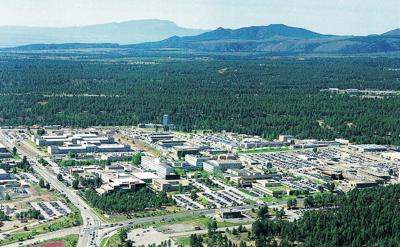“This is in direct contradiction to the National Environmental Policy Act’s requirement that federal agencies take a ‘hard look’ at proposed actions before implementation,” Jay Coghlan, executive director of Nuclear Watch New Mexico, said in a statement.
So much happened after 2008 that called for a new, thorough impact study years ago, including the plutonium facility’s “checkered nuclear safety history” that led to its major operations shutting down for more than three years, Coghlan said.
A new sitewide analysis now, Coghlan said, will merely “rubber stamp the billions of taxpayers’ dollars being sunk into a predetermined decision to expand plutonium pit production at LANL.”
By Scott Wyland swyland@sfnewmexican.com The Santa Fe New Mexican | August 19, 2022 santafenewmexican.com

The federal agency that oversees nuclear weapons will conduct a sitewide environmental review at Los Alamos National Laboratory, breaking from its past resistance to performing fresh analysis of potential impacts as the lab gears up to make 30 nuclear warhead triggers a year.
The National Nuclear Security Administration announced in the Federal Register on Friday it would do a sitewide analysis of the lab under the National Environmental Protection Act and would take public comment until Oct. 3.
It’s the first time the agency, a branch of the U.S. Department of Energy, has done a new sitewide environmental impact statement in 14 years.
Two years ago, agency officials said there was no need for a new sitewide study because little had changed overall since 2008 and that an abbreviated “supplement analysis” of the earlier study would suffice.
The agency now plans to do a comprehensive review of the lab’s operations, programs, technology, infrastructure and construction projects to determine if they must be improved or even overhauled to carry the lab through the next 15 years.
In an email, an agency spokeswoman wrote the decision in 2020 to forgo a new study was valid at the time and the agency is now adjusting to new circumstances.
“NNSA has not changed its mind,” spokeswoman Toni Chiri wrote. “The time is right to begin this new [sitewide review] as it will cover alternative activities to meet the full suite of NNSA mission requirements at Los Alamos National Laboratory.”
A watchdog group slammed what it called a belated effort, saying a full, updated review should have been done years ago before the lab began spending massive amounts of money to make bomb cores, also known as pits.
“This is in direct contradiction to the National Environmental Policy Act’s requirement that federal agencies take a ‘hard look’ at proposed actions before implementation,” Jay Coghlan, executive director of Nuclear Watch New Mexico, said in a statement.
So much happened after 2008 that called for a new, thorough impact study years ago, including the plutonium facility’s “checkered nuclear safety history” that led to its major operations shutting down for more than three years, Coghlan said.
A new sitewide analysis now, Coghlan said, will merely “rubber stamp the billions of taxpayers’ dollars being sunk into a predetermined decision to expand plutonium pit production at LANL.”
A longtime activist said the shorter analysis two years ago didn’t take into account all the new hiring, new construction and renovations that pit production would demand.
“They have to do a lot more than they thought in 2020,” said Greg Mello, executive director of Los Alamos Study Group. “The analysis in 2020 was wrong.”
Mello said NEPA offers a veneer of green credibility that in his view is hollow because the law contains no real environmental standards, only processes to follow and boxes to check off. If there are no standards to violate, then people have nothing on which to base legal challenges, Mello said.
The agency can say it followed the law, scrutinized the lab and let the public weigh in, even if it dismisses people’s comments, he said.
“NNSA is trying to provide legal protection for decisions it’s already made and a wide range of future decisions it might make,” Mello said.
The study will be multi-layered, with various options.
They include taking no action, continuing current operations, modernizing operations and expanding operations.
Those actions, such as modernizing and expanding, would cover not only the actual facilities and infrastructure but also programs related to the structures, such as decontamination and demolition, according to an agency news release.
The expansion alternative would make significant upgrades to facilities and would expand LANL’s capabilities beyond what currently exists, the agency said.
The new sitewide study comes as the agency is proposing a fatter budget in the coming year for Los Alamos and other national labs.
Los Alamos lab’s plutonium modernization funding would climb to $1.56 billion from this year’s $1 billion, a more than 50 percent increase.
It’s all to help the lab meet Trump-era goals — which the Biden administration is carrying on — of producing 30 pits a year, with the ability to surge to 80 pits for short periods. At the same, the Savannah River Site in South Carolina is slated to make 50 pits by the mid-2030s.
Mello said the “no action” option allows the agency to say much of what has been established requires no corrections, even if they’re flawed. That’s another thing the public can’t change, he said.
But Scott Kovac, Nuclear Watch’s operations director, offered a more hopeful perspective.
“Public participation will still be very important to identify environmental and social justice issues for analysis,” Kovac said. “We can get a better picture of radioactive wastes generated at LANL and the hazards to the community. But we’re going to have to get out in front and ask a lot of questions.”
